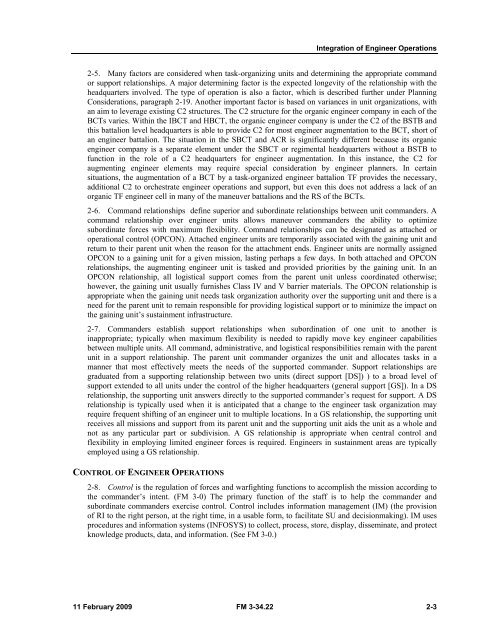FM 3-34.22 - Army Electronic Publications & Forms - U.S. Army
FM 3-34.22 - Army Electronic Publications & Forms - U.S. Army
FM 3-34.22 - Army Electronic Publications & Forms - U.S. Army
You also want an ePaper? Increase the reach of your titles
YUMPU automatically turns print PDFs into web optimized ePapers that Google loves.
Integration of Engineer Operations<br />
2-5. Many factors are considered when task-organizing units and determining the appropriate command<br />
or support relationships. A major determining factor is the expected longevity of the relationship with the<br />
headquarters involved. The type of operation is also a factor, which is described further under Planning<br />
Considerations, paragraph 2-19. Another important factor is based on variances in unit organizations, with<br />
an aim to leverage existing C2 structures. The C2 structure for the organic engineer company in each of the<br />
BCTs varies. Within the IBCT and HBCT, the organic engineer company is under the C2 of the BSTB and<br />
this battalion level headquarters is able to provide C2 for most engineer augmentation to the BCT, short of<br />
an engineer battalion. The situation in the SBCT and ACR is significantly different because its organic<br />
engineer company is a separate element under the SBCT or regimental headquarters without a BSTB to<br />
function in the role of a C2 headquarters for engineer augmentation. In this instance, the C2 for<br />
augmenting engineer elements may require special consideration by engineer planners. In certain<br />
situations, the augmentation of a BCT by a task-organized engineer battalion TF provides the necessary,<br />
additional C2 to orchestrate engineer operations and support, but even this does not address a lack of an<br />
organic TF engineer cell in many of the maneuver battalions and the RS of the BCTs.<br />
2-6. Command relationships define superior and subordinate relationships between unit commanders. A<br />
command relationship over engineer units allows maneuver commanders the ability to optimize<br />
subordinate forces with maximum flexibility. Command relationships can be designated as attached or<br />
operational control (OPCON). Attached engineer units are temporarily associated with the gaining unit and<br />
return to their parent unit when the reason for the attachment ends. Engineer units are normally assigned<br />
OPCON to a gaining unit for a given mission, lasting perhaps a few days. In both attached and OPCON<br />
relationships, the augmenting engineer unit is tasked and provided priorities by the gaining unit. In an<br />
OPCON relationship, all logistical support comes from the parent unit unless coordinated otherwise;<br />
however, the gaining unit usually furnishes Class IV and V barrier materials. The OPCON relationship is<br />
appropriate when the gaining unit needs task organization authority over the supporting unit and there is a<br />
need for the parent unit to remain responsible for providing logistical support or to minimize the impact on<br />
the gaining unit’s sustainment infrastructure.<br />
2-7. Commanders establish support relationships when subordination of one unit to another is<br />
inappropriate; typically when maximum flexibility is needed to rapidly move key engineer capabilities<br />
between multiple units. All command, administrative, and logistical responsibilities remain with the parent<br />
unit in a support relationship. The parent unit commander organizes the unit and allocates tasks in a<br />
manner that most effectively meets the needs of the supported commander. Support relationships are<br />
graduated from a supporting relationship between two units (direct support [DS]) ) to a broad level of<br />
support extended to all units under the control of the higher headquarters (general support [GS]). In a DS<br />
relationship, the supporting unit answers directly to the supported commander’s request for support. A DS<br />
relationship is typically used when it is anticipated that a change to the engineer task organization may<br />
require frequent shifting of an engineer unit to multiple locations. In a GS relationship, the supporting unit<br />
receives all missions and support from its parent unit and the supporting unit aids the unit as a whole and<br />
not as any particular part or subdivision. A GS relationship is appropriate when central control and<br />
flexibility in employing limited engineer forces is required. Engineers in sustainment areas are typically<br />
employed using a GS relationship.<br />
CONTROL OF ENGINEER OPERATIONS<br />
2-8. Control is the regulation of forces and warfighting functions to accomplish the mission according to<br />
the commander’s intent. (<strong>FM</strong> 3-0) The primary function of the staff is to help the commander and<br />
subordinate commanders exercise control. Control includes information management (IM) (the provision<br />
of RI to the right person, at the right time, in a usable form, to facilitate SU and decisionmaking). IM uses<br />
procedures and information systems (INFOSYS) to collect, process, store, display, disseminate, and protect<br />
knowledge products, data, and information. (See <strong>FM</strong> 3-0.)<br />
11 February 2009 <strong>FM</strong> 3-<strong>34.22</strong> 2-3

















